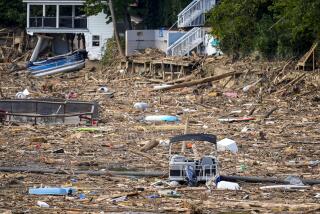Beware Section 702c
- Share via
The tragic flooding in the Midwest is the latest episode in an endless cycle of American life: record rains, catastrophic flooding and doing nothing to prevent a recurrence. This drama has been played out for generations along the 2,350 miles of the nation’s longest river.
In 1927, the Mississippi River flooded seven states from Illinois to Louisiana, killing 246 people, displacing 700,000 residents and causing more than $400 million in damage -- a staggering sum at the time. Swollen by months of heavy rains, the mighty river escaped its levee system in 145 places, inundating 27,000 square miles with up to 30 feet of water.
The Great Flood of 1993 flooded 30,000 square miles, ruined 10,000 homes, killed several dozen people and inflicted $15 billion in damages.
The latest installment features raging flood waters that have broken 20 levees along hundreds of miles of the Mississippi River’s overtopped banks. So far, 24 people have perished, 35,000 homes have been destroyed and tens of thousands of Upper Mississippi River Valley residents have been displaced. Preliminary estimates place property damages in the hundreds of millions of dollars.
When the flood waters eventually recede, the latest flood victims, like their Hurricane Katrina counterparts (who I represent in a similar case in New Orleans), will probably learn that levees built by the U.S. Army Corps of Engineers failed catastrophically. They will probably also discover that the state, local and private levees along the Mississippi and its tributaries were not inspected by the Army Corps as mandated by Congress. Indeed, the federal agency is clueless as to where thousands of the nation’s levees are even located.
But the rudest awakening of all will be the realization that victims of official negligence in designing, constructing and inspecting flood levees cannot hold their government accountable in a court of law.
In the wake of the worst flooding in American history, Congress enacted the Flood Control Act of 1928. The Army Corps -- the federal agency of public engineers and construction managers that is supposedly the master of flood protection -- was charged in the new law with the responsibility of protecting the people and property of the Mississippi River Valley.
Buried in this historic legislation, however, were the following 25 words in Section 702c: “no liability of any kind shall attach or rest upon the United States for any damage from or by floods or flood waters at any place.”
Over the intervening 80 years, this terse sentence has been used by Justice Department lawyers to defeat scores of lawsuits seeking compensation for loss of life and property allegedly caused by shoddy work performed by the Army Corps’ engineers. Federal courts have interpreted the provision as a blanket immunity for the government from any damage claims, including cases in which there is evidence of engineering malpractice or even gross negligence. The Supreme Court has ruled that if the project’s purpose is flood control, the corps can do no wrong.
Section 702c has been successfully invoked to defeat suits against the corps in cases ranging from drowning victims in improperly operated reservoirs, to ruptured levees that flooded 85,000 acres of land along the Feather River near Yuba City, to the destruction of an entire Oregon town that resulted in 14 deaths.
The most notorious application of this sweeping immunity statute occurred recently in one of the Hurricane Katrina class-action lawsuits. U.S. District Judge Stanwood J. Duval Jr. reluctantly dismissed all flooding cases involving the Army Corps’ admitted negligence in building the flood walls along the 17th Street and London Avenue canals in New Orleans. At the same time, the judge excoriated the Army Corps for dereliction of duty, writing that it was guilty of “egregious myopia” and that it had squandered millions of dollars on a system known to be “inadequate” and “flawed from practically the outset.” (My case involves another class of Katrina victims suing the Army Corps for the flooding of New Orleans East, St. Bernard Parish and the Lower 9th Ward. Duval has twice held that in our case, because of the nature of the flooding, the Army Corps is not protected by Section 702c.)
Besides being a relic of a time before the Federal Tort Claims Act of 1946 repealed sovereign immunity for negligence by federal employees, this law does not serve the interest of the public. Immunizing engineering design errors, shoddy construction and inept inspections of flood protection projects creates a perverse disincentive. Without accountability, the Army Corps has little financial incentive to comply with accepted professional standards for building and maintaining protective structures.
If a private construction firm had designed and constructed the Greater New Orleans flood protection system, it would be held responsible, and victims would be entitled to just compensation. The perpetuation of this dual standard is unjustifiable. This is particularly true when the Army Corps must admit, as chief engineer Lt. Gen. Carl A. Strock did in 2006, that it was responsible for the 50 levee breaches that drowned New Orleans and adjacent St. Bernard Parish.
In the wake of Katrina, not a single Army Corps official has been dismissed, disciplined or demoted. Nor has the federal government paid a penny in reparations. With more than 100 federal dams in this country and 15,000 miles of levees, it is only a matter of time before flood waters add to the expanding roll of victims of government incompetence and neglect.
By immediately repealing Section 702c, Congress can eradicate this archaic immunity law described by Supreme Court Justice John Paul Stevens as an “anachronism” and “an obsolete legislative remnant [that] is nothing more than an engine of injustice.” Otherwise, in the haunting words of Judge Duval, “it is certain that another tragedy such as [Katrina] will occur again.”
More to Read
Sign up for Essential California
The most important California stories and recommendations in your inbox every morning.
You may occasionally receive promotional content from the Los Angeles Times.












